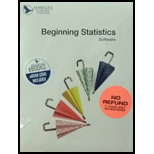
a.
To find:
The probability of random variable less than given
Answer to Problem 15CR
Solution:
The required probability is
Explanation of Solution
Given:
In statistics, a measurable
The normal distribution is the most prevalent continuous
In the normal distribution (also known as Gaussian or Gauss-Laplacian) distribution, the probability density function is given by:
Where,
The normal Gaussian distribution with the following characteristics:
is called standard normal distribution.
The appropriate probability density function transforms to
A normal distribution can be converted to standard normal distribution by defining the
where
The probabilities being calculated using the
Calculation:
Given value of random variable
Thereafter, the relation
First, the
Then, from the table:
which in turn gives:
Conclusion:
The required probability is
b.
To find:
Value of the mean.
Answer to Problem 15CR
Solution:
The value of the mean is
Explanation of Solution
Given:
Description:
In statistics, a measurable function that is used to represent outcomes or occurrences of random phenomenon as real numbers is defined as a random variable.
The normal distribution is the most prevalent continuous probability distribution function and the real world hosts a milieu of the variables that are normally distributed.
In the normal distribution (also known as Gaussian or Gauss-Laplacian) distribution, the probability density function is given by:
Where,
The normal Gaussian distribution with the following characteristics:
is called standard normal distribution.
The appropriate probability density function transforms to
A normal distribution can be converted to standard normal distribution by defining the
where
Calculation:
Given value of probability
before which the
The
Here, the mean has to be computed:
Rounding off to two decimals places gives:
Conclusion:
The value of the mean is
c.
To find:
The standard deviation for given data.
Answer to Problem 15CR
Solution:
The required standard deviation is
Explanation of Solution
Given:
Description:
In statistics, a measurable function that is used to represent outcomes or occurrences of random phenomenon as real numbers is defined as a random variable.
The normal distribution is the most prevalent continuous probability distribution function and the real world hosts a milieu of the variables that are normally distributed.
In the normal distribution (also known as Gaussian or Gauss-Laplacian) distribution, the probability density function is given by:
Where,
The normal Gaussian distribution with the following characteristics:
is called standard normal distribution.
The appropriate probability density function transforms to
A normal distribution can be converted to standard normal distribution by defining the
where
Calculation:
Given the value of probability
before which the
The
Here, the standard deviation is to be calculated:
This value rounded off to the
Conclusion:
The required standard deviation is
d.
To find:
The
Answer to Problem 15CR
Solution:
The required
Explanation of Solution
Given:
Description:
In statistics, a measurable function that is used to represent outcomes or occurrences of random phenomenon as real numbers is defined as a random variable.
The normal distribution is the most prevalent continuous probability distribution function and the real world hosts a milieu of the variables that are normally distributed.
In the normal distribution (also known as Gaussian or Gauss-Laplacian) distribution, the probability density function is given by:
Where,
The normal Gaussian distribution with the following characteristics:
is called standard normal distribution.
The appropriate probability density function transforms to
A normal distribution can be converted to standard normal distribution by defining the
where
Calculation:
Given the value of probability
before which the
The
Then, the
This number rounded off to the nearest whole number gives:
Conclusion:
The required
Want to see more full solutions like this?
Chapter 6 Solutions
BEGINNING STATISTICS-CD (NEW ONLY)
 MATLAB: An Introduction with ApplicationsStatisticsISBN:9781119256830Author:Amos GilatPublisher:John Wiley & Sons Inc
MATLAB: An Introduction with ApplicationsStatisticsISBN:9781119256830Author:Amos GilatPublisher:John Wiley & Sons Inc Probability and Statistics for Engineering and th...StatisticsISBN:9781305251809Author:Jay L. DevorePublisher:Cengage Learning
Probability and Statistics for Engineering and th...StatisticsISBN:9781305251809Author:Jay L. DevorePublisher:Cengage Learning Statistics for The Behavioral Sciences (MindTap C...StatisticsISBN:9781305504912Author:Frederick J Gravetter, Larry B. WallnauPublisher:Cengage Learning
Statistics for The Behavioral Sciences (MindTap C...StatisticsISBN:9781305504912Author:Frederick J Gravetter, Larry B. WallnauPublisher:Cengage Learning Elementary Statistics: Picturing the World (7th E...StatisticsISBN:9780134683416Author:Ron Larson, Betsy FarberPublisher:PEARSON
Elementary Statistics: Picturing the World (7th E...StatisticsISBN:9780134683416Author:Ron Larson, Betsy FarberPublisher:PEARSON The Basic Practice of StatisticsStatisticsISBN:9781319042578Author:David S. Moore, William I. Notz, Michael A. FlignerPublisher:W. H. Freeman
The Basic Practice of StatisticsStatisticsISBN:9781319042578Author:David S. Moore, William I. Notz, Michael A. FlignerPublisher:W. H. Freeman Introduction to the Practice of StatisticsStatisticsISBN:9781319013387Author:David S. Moore, George P. McCabe, Bruce A. CraigPublisher:W. H. Freeman
Introduction to the Practice of StatisticsStatisticsISBN:9781319013387Author:David S. Moore, George P. McCabe, Bruce A. CraigPublisher:W. H. Freeman





